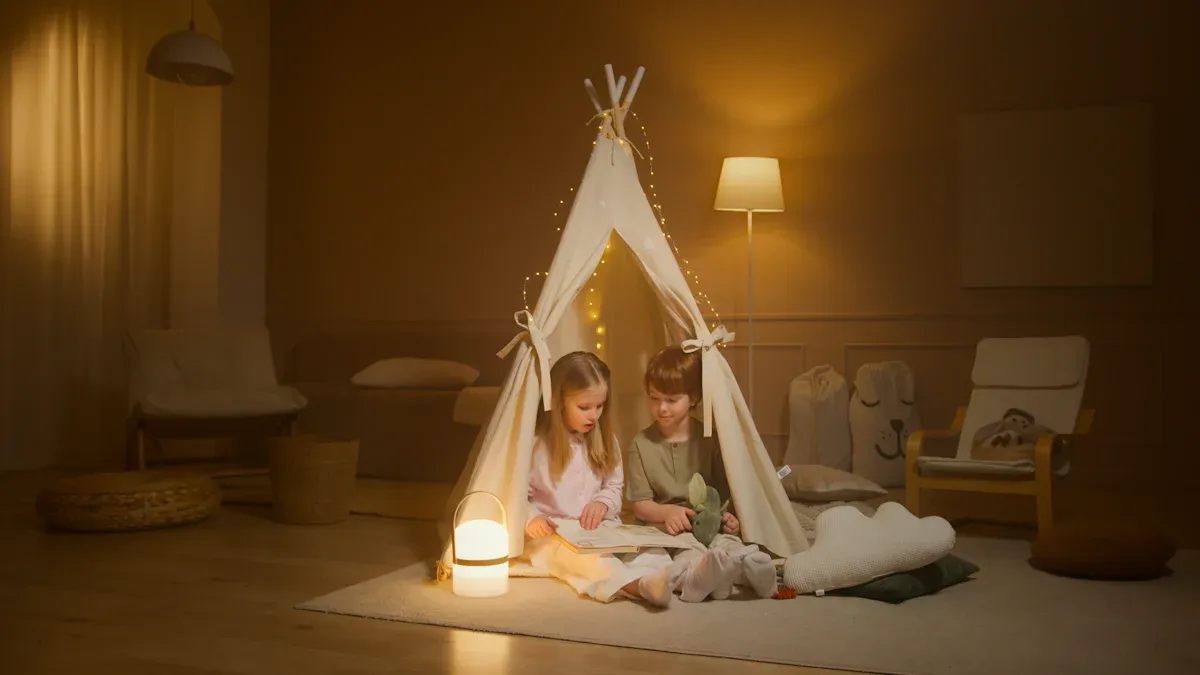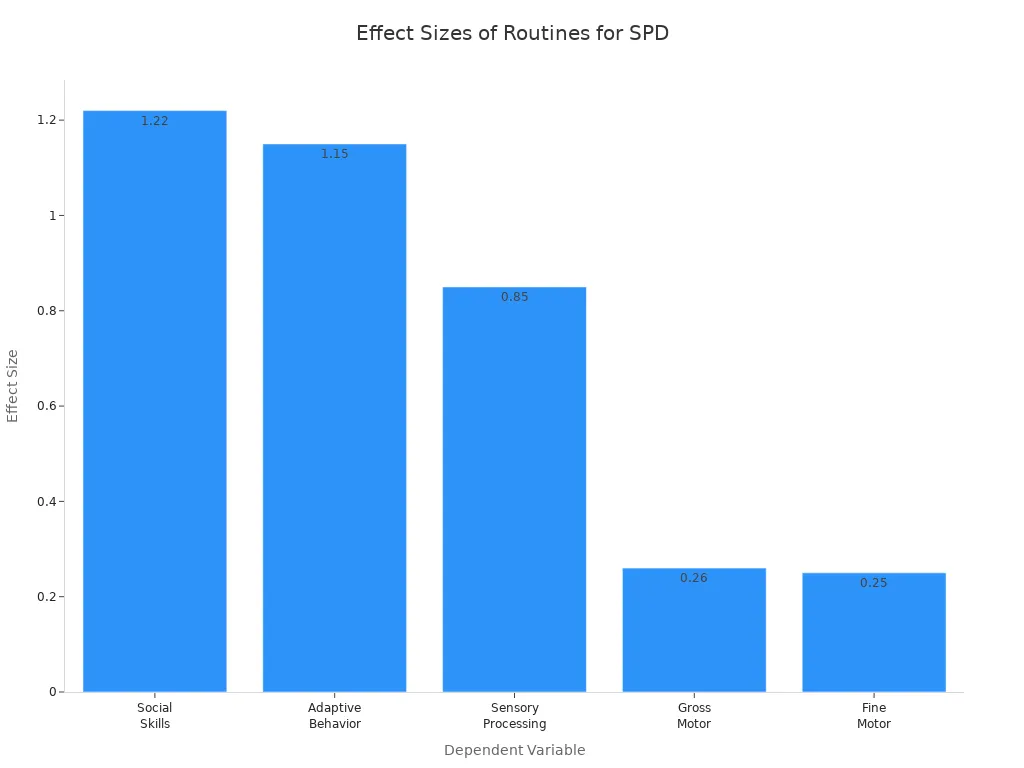Top Strategies for Navigating the Sensory World

You may feel stressed by the sensory world your child faces. Many other families feel the same way. More than half of kids in clinical groups have sensory processing problems. Kids with autism have sensory challenges between 40% and 88% of the time. You notice your child has trouble with sounds, lights, or textures. You want easy ways to help your child. Experts often recommend deep-pressure hugs, soft lights, and calming activities. These things can help kids in the sensory world. You might wonder how to make a helpful sensory world at home, school, or anywhere else. This blog gives you real-life stories and tips to help you handle the sensory world with confidence.
Key Takeaways
Learning about sensory processing disorder helps you see your child's special needs. It also helps you notice their challenges.
Making sensory-friendly places at home and school can lower anxiety. It can help children with sensory issues focus better.
Using sensory journals lets you watch your child's reactions to things. This helps you find triggers and make good plans.
Setting routines and using visual schedules gives structure. This makes daily tasks easier and less stressful for your child.
Speaking up for your child's needs at school and in the community helps them get the support they need to do well.
Understanding Sensory Processing Disorder
What Is SPD?
You might hear about sensory processing disorder and feel confused. Sensory processing is how the brain uses information from your senses. These senses are touch, sound, sight, taste, and smell. Most people’s brains handle this easily. If you hear a loud noise, you cover your ears. If you touch something soft, you feel calm.
Some kids’ brains work differently with sensory information. They might get too much or too little from their senses. This can make normal things feel hard or strange. Many children have sensory processing disorder. Here are some facts:
About 5% to 16.5% of all kids have sensory processing disorder.
Kids with autism or ADHD have even more sensory challenges.
You might see your child react strongly to sounds or textures. They may avoid bright lights or want to move a lot. These are signs that sensory processing is different for them.
Common Family Challenges
Having sensory processing differences can be tough for families. You may see your child struggle with things that seem easy for others. Some common problems are:
Trouble with certain sensory input, like loud sounds or itchy clothes
Behavior problems, like meltdowns or tantrums
You might also notice these behaviors:
Throwing tantrums when getting dressed
Feeling pain much more or much less than others
Bumping into walls or people
Putting things that are not food in their mouths
Tip: You are not alone. Many families deal with these problems every day. Learning about sensory processing can help you help your child and find what works for your family.
Identifying Sensory Triggers
Spotting Patterns
You may see your child react to certain sounds or textures. Some kids feel too much from things like loud noises or scratchy clothes. Others do not notice these things at all. You can find patterns by watching your child each day. Does your child cover their ears when the vacuum is on? Do they not notice cold water or bright lights?
Tip: Carry a small notebook with you. Write down what happens before, during, and after your child reacts. This helps you know what makes your child feel stressed or calm.
Here are some ways to find triggers:
Watch for things your child does again and again, like chewing on a shirt or not eating some foods.
Look for signs your child feels too much, like flinching or hiding from loud sounds.
Notice if your child does not react to pain or misses social cues.
Try to help your child notice how they feel about different things.
Sensory Journals
A sensory journal can help your family a lot. You write down what your child does, feels, and says during different times. You might see your child feels too much at the store or does not notice things during play. The journal helps you see patterns and plan for next time.
You can use a table to keep your notes organized:
Time/Place | Sensory Input | Child’s Reaction | Notes |
|---|---|---|---|
Morning, Home | Brushing teeth | Over-responsivity | Screams, covers mouth |
Afternoon, Park | Sand | Under-responsivity | No reaction, keeps playing |
You can also try exposure exercises. Let your child slowly get used to things like tags on shirts or new smells. After a while, your child may feel less stress and more comfort.
Note: Sensory journals help you learn what works and what does not. You can show this to teachers or therapists to get more help.
Sensory-Friendly Spaces

Creating a sensory-friendly oasis can make a huge difference for your child. You want your home, school, and public places to feel safe and welcoming. When you focus on sensory processing needs, you help your child feel calm, focused, and ready to learn or play. Let’s look at how you can build these spaces in different parts of your child’s life.
Home Tips
Your home can become a sensory-friendly oasis with a few simple changes. Start by thinking about what helps your child feel comfortable. Many families find that small adjustments can lower stress and make daily routines smoother.
Use soft, adjustable lighting. Lamps with dimmers or blackout curtains help control brightness.
Keep spaces organized and clutter-free. Too many things in a room can overwhelm your child’s sensory processing.
Add calming features like weighted blankets, bean bag chairs, or soft rugs.
Create a quiet zone or sensory corner. This can be a tent, a cozy chair, or a small nook with pillows.
Offer sensory tools like fidget toys, stress balls, or textured objects. Leemoland sensory toys, such as squishy balls and textured fidgets, give your child something safe to touch and squeeze when they need to calm down.
Tip: Sensory tools and toys help your child manage big feelings. They can squeeze, twist, or roll these toys to release energy or relax.
Research shows that these changes help children regain focus and feel comfortable. When you use noise-canceling headphones or soft lighting, you reduce anxiety and help your child participate in family routines. Organized spaces and sensory breaks also lower the chance of meltdowns and help your child self-regulate.
School Tips
School can feel overwhelming for kids with sensory processing challenges. You can work with teachers to make the classroom more comfortable. Many schools now use sensory-friendly strategies to help all students succeed.
Ask about flexible seating, like wobble cushions or bean bag chairs.
Suggest movement breaks during the day. Short walks, wall push-ups, or jumping jacks help your child reset.
Encourage the use of fidget toys or stress balls at desks. Leemoland sensory toys fit easily in a backpack or pencil case and give your child a quiet way to stay focused.
Request a calm space in the classroom. This can be a corner with soft lighting, headphones, or weighted blankets.
Talk to teachers about minimizing distractions. Simple changes, like moving your child’s desk away from noisy areas, can help.
Note: Sensory-friendly spaces at school empower your child to manage their sensory processing needs. These changes help reduce anxiety, increase focus, and make it easier for your child to join in classroom activities.
Teachers and parents often see fewer disruptions and more self-regulation when kids have access to sensory tools and breaks. Sensory-friendly classrooms help all students, not just those with sensory processing differences.
Public Spaces
Public places like stores, parks, or waiting rooms can be tough for kids with sensory processing challenges. You can plan ahead and bring tools to help your child feel safe and included.
Pack a small bag with sensory toys from Leemoland. Fidget spinners, stretchy bands, or textured balls can help your child stay calm in busy places.
Use noise-canceling headphones to block out loud sounds.
Look for quiet areas or family restrooms where your child can take a break.
Choose times when places are less crowded, like early mornings or weekdays.
Talk to staff if you need help. Many places now offer sensory-friendly hours or special accommodations.
Tip: Sensory-friendly public spaces help everyone feel welcome. Sensory toys and quiet zones give your child a way to manage new sights, sounds, and smells.
Sensory-friendly spaces in public help your child adapt to new environments. Sensory rooms and toys support children with autism and other sensory processing needs by reducing anxiety and helping them focus. When you bring sensory tools, you create a more enjoyable and less stressful experience for your whole family.
By making small changes at home, school, and in public, you build a world where your child can thrive. Sensory-friendly spaces support your child’s sensory processing and help them feel safe, calm, and ready for anything.
Building Routines
Structure Matters
Kids do better when they have routines. Routines help children with sensory processing disorder feel safe. When you make a daily plan, your child feels more in control. You may see fewer meltdowns and more happy faces.
Studies show routines help kids in many ways. They improve social skills, adaptive behavior, and sensory processing. Here is a table that shows how routines help:
Dependent Variable | Effect Size |
|---|---|
Social Skills | 1.22 |
Adaptive Behavior | 1.15 |
Sensory Processing | 0.85 |
Gross Motor | 0.26 |
Fine Motor | 0.25 |

You can start routines with easy steps. Wake up at the same time every day. Eat meals together as a family. Use Leemoland sensory toys, like fidget spinners or squishy balls, when changing activities. These toys help your child stay calm and pay attention.
Tip: Make sure routines can change if needed. If your child gets upset, give them a sensory break with a favorite toy or let them have some quiet time.
Visual Schedules
Visual schedules make routines simple to follow. You can use pictures, charts, or cards to show what happens next. Kids with sensory challenges often like visual information. These schedules help your child know what is coming and feel less worried.
Here is a table that explains how visual schedules help:
Evidence Description | Impact on Daily Functioning |
|---|---|
Visual schedules provide structure and predictability. | Reduces anxiety and improves engagement in activities. |
They cater to the preference for visual information. | Enhances understanding and communication of expectations. |
Supports smoother transitions between tasks. | Alleviates feelings of overwhelm associated with changes. |
Increases predictability and structure. | Eases anxiety related to unknown schedules. |
Enhances communication and language skills. | Supports growing language abilities. |
Improves attention and focus on activities. | Enhances overall engagement in daily routines. |
Visual schedules help your child know what will happen next. This lowers stress.
They give a clear plan for the day, so routines are easier to follow.
You may notice better behavior and more calm times.
Try using a chart on the fridge or cards in your child’s backpack. Add Leemoland sensory toys to the schedule as rewards or calming tools. Your child will feel ready and confident for each part of the day.
Sensory Diets & Activities

A sensory diet is a plan with activities for your child. These activities help your child feel calm and ready for each day. You work with occupational therapy experts to make this plan. The plan changes as your child grows older. Occupational therapists look at your child’s sensory needs. They choose activities that help your child pay attention and feel better.
Calming Activities
You want your child to feel safe and calm. Calming activities help lower stress and make things easier. Here are some ideas you can try at home:
Make a quiet corner with soft pillows and blankets.
Fill a bin with rice, beans, or sand for your child to touch.
Let your child play with water by pouring or splashing.
Take walks outside so your child can move and relax.
Try a pillow sandwich game for deep pressure.
Leemoland sensory toys, like squishy balls and textured fidgets, are good for calming. Your child can squeeze, roll, or twist these toys to relax. Sensory play also helps your child learn to share and take turns. It helps your child show feelings. You may see fewer outbursts and more smiles when things get hard.
Alerting Activities
Sometimes your child needs help to stay awake and active. Alerting activities help your child move and pay attention. You can use jumping, squeezing, or music in your sensory diet. Leemoland sensory toys, like stretchy bands or fidget spinners, help your child move and focus.
Here is a table that shows how alerting activities help:
Benefit | Description |
|---|---|
Improved Sensory Regulation | Alerting activities help your child manage sensory responses. |
Increased Tolerance to Sensory Stimuli | Your child builds the ability to handle sensory input without overwhelm. |
Enhanced Engagement in Daily Activities | Your child gets more involved in everyday tasks and feels more independent. |
Leemoland sensory mouth toys help with chewing needs. These toys fit into daily routines and help with mouth skills. You can talk to occupational therapy experts to change your child’s sensory diet as needed. Working together helps your child do well in all parts of life.
Navigating Sensory Challenges
Communication Tips
You deal with sensory challenges every day. Talking about these challenges helps others understand your child. Share what works at home with teachers. Tell them about sensory diets, quiet spaces, and favorite sensory toys. Good communication helps a lot. When you talk to teachers, you can ask for changes in the classroom. You might ask for noise-canceling headphones or fidget tools. These tools help your child at school.
Making a support network gives you more ideas. Work with school teams to make a plan for your child. You can join online forums and local workshops. These places help you learn new ways to handle sensory challenges. Family support is important too. Teach siblings and grandparents about sensory challenges. This way, everyone can help your child. Early help stops problems from getting bigger. Make a plan for your child and check it often.
Here’s a table with top communication strategies:
Strategy | Description |
|---|---|
Talk with teachers to set up classroom tools and supports. | |
Building a Support Network | Work with school teams to make a sensory management plan. |
Sensory-Friendly Environments | Use sensory diets and home changes to support your child. |
Tip: Share your child’s sensory challenges with teachers and family. This helps others support your child.
Advocacy in School & Community
Advocating for your child means speaking up for their needs. You can teach counselors and teachers about sensory challenges. Ask for things like Section 504 plans. These plans help your child get support at school.
Some strategies work well. You can ask for noise-canceling headphones, movement breaks, and fidget toys. Preferential seating and quiet spaces help your child. Natural lighting is better than harsh lights.
Here are some ways to advocate for sensory challenges:
Ask for sensory breaks during the day.
Request quiet spaces for your child.
Suggest movement breaks and wiggle cushions.
Share your child’s sensory profile with teachers.
Work with professionals to adjust plans as needed.
Note: When you speak up for sensory challenges, you help your child feel safe. You make school and community spaces better for everyone.
Family Self-Care
Managing Stress
Taking care of a child with sensory processing challenges can be hard. You may feel your own stress getting worse. Looking after yourself helps you care for your child better. Try easy self-care habits every day. Go for a walk, stretch, or dance to music you like. Moving your body can lower stress and make you feel happier. Meditation or deep breathing can help you feel calm. Even a few quiet minutes can help a lot.
You can also do hobbies you enjoy. Read a book, draw, or listen to music. These things give your mind a break. Doing calming things together as a family, like deep breathing or gentle yoga, can help everyone relax.
Here’s a quick look at some helpful self-care strategies:
Strategy | Benefit |
|---|---|
Regular Exercise | Reduces stress, improves health |
Professional Help | Offers coping strategies |
Support Networks | Reduces isolation, provides tips |
Remember: Your well-being matters. When you manage your stress, your whole family feels the difference.
Finding Support
You do not have to do everything by yourself. Many families have the same challenges. Support networks can help you feel less alone and give you new ideas. You can join local groups, online forums, or parent workshops. These places let you share stories and learn from others.
You might find help for evaluations and IEPs, tips for classroom changes, and ideas for sensory-friendly routines. Some groups give advice on therapies or behavior plans. Others help you meet professionals who know about sensory needs.
Join a support group for parents of kids with sensory processing disorder.
Ask your child’s school about classroom accommodations.
Look for online communities that share sensory-friendly tips.
Reach out to therapists for guidance and coping strategies.
Tip: Sharing your journey with others can lift your spirits and help you find new solutions. You are not alone on this path.
Exploring the Sensory World: Real-Life Examples
Grocery Store Scenario
You and your child go to a busy grocery store. The lights are very bright. The sounds are loud and hard to ignore. Your child covers their ears and looks upset. You take out a Leemoland fidget toy from your bag. Your child squeezes the toy and feels the texture. This helps them handle the noise and lights. You also use noise-canceling headphones. You find a quiet aisle in the store. Your child helps you pick snacks. Many families use these sensory strategies. They make shopping and other routines easier and less stressful.
School Event Scenario
School events have many new sensory experiences. Your child gets restless during a school assembly. You give them a Leemoland stretchy band. They stretch and twist it under their seat. This helps your child stay calm and pay attention. Teachers use sensory strategies in classrooms. These help kids with sensory processing issues, including autism. Sensory tools help your child join group activities. They also make learning with friends more fun.
Here is a quick look at how Leemoland sensory toys support different needs:
Type of Toy | Benefits |
|---|---|
Tech-enhanced toys | Help with balance, coordination, and social skills for kids with autism. |
Adaptive designs | Meet different sensory needs using touch, sight, and sound. |
Neurodiverse toys | Support many sensory needs, like movement and sound. |
Screen-free toys | Let kids explore with their hands and build motor skills. |
Calm Space at Home
You make a calm space at home for your child. The space has soft pillows and gentle lights. There is a basket with Leemoland sensory toys. After a busy day, your child goes to this space. They pick a squishy ball or a textured fidget. These sensory toys help your child relax and feel better. Many therapists help families add sensory experiences to daily routines. This can be at bedtime or mealtime. You see your child feel safe and ready for what comes next.
Tip: Small changes and the right sensory tools can turn everyday moments into good sensory experiences for your child.
Resources for Sensory Processing
Getting good resources can make things easier. You have lots of ways to learn and get help. Here are some places you can check out.
Helpful Websites
You want simple answers and good advice. These websites have trusted facts about sensory processing and ways to help your child:
Resource Name | Description | Link |
|---|---|---|
Shares lots of info and activities for kids. | ||
Autism Speaks | Gives support and resources for sensory processing disorder. |
You can look at these sites to learn more. Find ideas for activities and read stories from other families.
Support Groups
Meeting other parents helps you feel better. Support groups let you talk, share, and get advice about sensory processing. Here are some places you can join:
Group Name | Link |
|---|---|
https://sensoryprocessingdisorderparentsupport.com/sensoryprocessingdisordercommunity | |
Sensory Processing Disorder Parent Support | |
Sensory Processing Disorder Parent (Facebook page) | https://www.facebook.com/sensoryprocessingdisorderparentsupport |
Neurodiverse Parent Support - ADHD Parent Support (Facebook group) | |
Sensory Processing Disorder Parent Support (Facebook group) | |
ADHD & ODD Parent Support - Oppositional Defiant Disorder (Facebook group) |
You can ask questions and share tips. Learn new ways to handle sensory processing challenges.
Professional Help
Sometimes you need help from experts. These groups give advice and resources for sensory processing. You can contact them for support:
Organization Name | Website |
|---|---|
Sensory Processing Disorder Foundation | |
Zero to Three |
Occupational therapists can help you make a plan for your child.
Tip: You can also go to the Leemoland official website for sensory toys and advice. Leemoland has tips for making sensory rooms and picking toys. They show why sensory toys matter for kids with Autism and ADHD. You will find help for choosing and using sensory toys.
Leemoland gives:
Sensory toys for different needs.
Tips for building sensory rooms at home or school.
Educational toys for learning and growing.
You have many ways to help your family. Try these options and see what works best for your child’s sensory processing needs.
You can help your child do well in the sensory world in many ways. Finding sensory needs early makes things easier. Fun sensory activities and calm spaces help every day feel better. Occupational therapists can give you tips just for your child. Using sensory toys and routines helps your child focus, handle feelings, and get along with others. These ideas help your family grow and feel happy. Keep trying new things and stay positive. You can make a happy and helpful place for your child.
FAQ
What is a sensory diet?
A sensory diet is a set of activities you use to help your child feel calm or alert. You can work with an occupational therapist to build a plan. Sensory toys, like those from Leemoland, fit right into these routines.
How do I know if my child needs sensory toys?
You might notice your child fidgets, chews, or avoids certain textures. Sensory toys can help them focus or relax. If you see these signs often, try adding sensory toys to your daily routine.
Can sensory tools help at school?
Yes! Sensory tools like fidget toys or stretchy bands help your child stay focused and calm in class. You can talk to teachers about using these tools during lessons or breaks.
Where can I find more sensory resources?
You can visit the Leemoland official website for sensory toys, tips, and ideas. You will also find guides for building sensory spaces at home or school.
See Also
Easy Strategies for Creating a Sensory Corner
Best Practices for Crafting Sensory Rooms in Education
Design Ideas for Tranquil Multi-Sensory Environments
